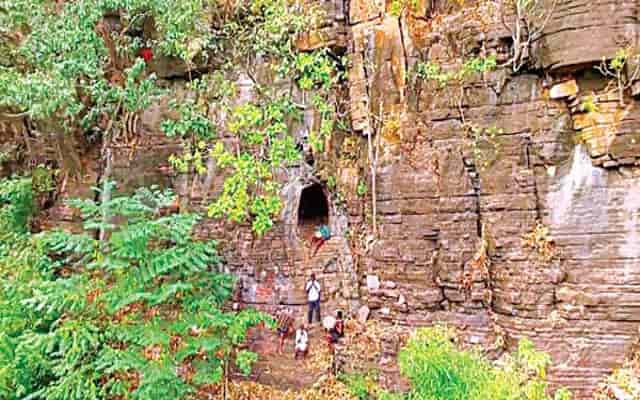Jungles, forests and wooded areas have kept concealed and protected remnants – monuments and artefacts — of some of the ancient civilisations from looters and vandals, like that of ancient Mayans and the lost city of Cambodia.
In India, there is one such prehistoric place that has kept hidden remnants of an ancient civilisation, and this is the Arjuna Loddi caves. These caves are located in the dense jungles of the Kawal Tiger Reserve.
The reserve is located in Telangana State’s Jannaram mandal in Mancherial District (Old Adilabad district).
Last week, archaeologists and historians along with the assistance and help from the forest officials and personnel deciphered the secrets in these caves.
Also read: Dholavira — an Indus Valley mega-city — joins 39 others in UNESCO's World Heritage list
Going back to tradition and history, the Gonds and Paradhans belonging to the Mesramguda village in Tiryani mandal of Kumrambheem Asifabad district have held the belief that Pandavas had spent their exile in the forests of Kawal Tiger Reserve.
We cut to the present and find that even now the tribals in this region worship a limestone deep inside these caves as ‘Arjun Pein’ which refers to Arjuna as God. What is significant about these caves is that they are all made of limestone.
M.A. Srinivasan, who is the general secretary of Public Research Institute for History, Archaeology and Heritage, and the Forest Range Officer of Ginnedhari Pranay went to these caves to explore it up to 30 metres distance. To reach the spot, they had to negotiate dangerous terrain.
In a report by the Express News Service, according to Sreenivasan, the formation of caves had started during the neoproterozoic era, around 54 crore years ago, when groundwater continuously cut through the limestone layer. According to him this resulted in the creation of the caves in a period which was between 1,25,000 BC and 10,000 BC.
Supporting this theory of Sreenivasan, is Ch Venugopal Rao, former Deputy Director of the Geological Survey of India. Rao observed that by keeping in mind the scientific research which was done on similar caves found in Kurnool, it was possible to estimate when Arjuna Loddi caves were formed.
Also read: New Buddha statue to come up at Pragbodhi – where the Lord meditated for six years
There is another significant and interesting facet about these caves. It is the formation of stalactites and stalagmites. While the former are the icicle-shaped formations that hang from the ceiling of the caves and the latter are formations which rise from the floor of the cave which is due to the collection of mineral deposited from the floor to the ceiling.
The limestone which is respected and worshipped by the tribals – Arujana Pein — is one such stalagmite located in these caves.
Those who explored the caves also found important tools and implements. These included tools like scrapers and implements which were most probably used by early humans from that period during which a prehistoric civilization flourished inside this forest.
In order to promote the place, Arjun Loddi, it was suggested by the explorers that eco-tourism and adventure tourism should be allowed as the area is perfect site for these activities.




















